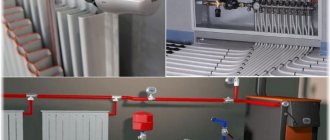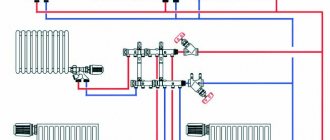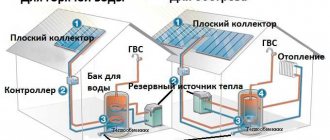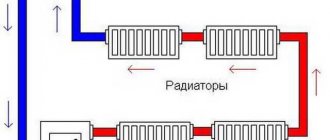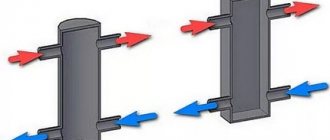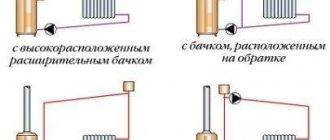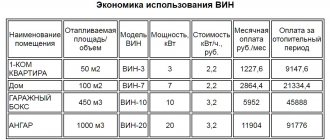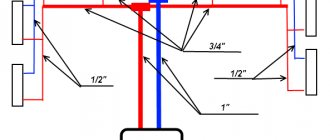The principle of operation of heating systems with natural circulation
The gravity heating system of a private house is organized taking into account physical laws. The difference between the density and weight of the heated and cooled liquid contributes to the natural flow of coolant in the network. There is practically no pressure in the circuit and is only 0.5-0.7 atmospheres.
Since the volume of liquid increases during the heating process, an expansion tank is installed in the circuit. Its main purpose is to balance the pressure in the system. Excess expanded liquid enters this container, and when the pressure in the network decreases, water from the tank passes back into the pipelines. The expansion tank is installed at the highest point of the network after the accelerating vertical riser.
Heated floors can be connected to the gravity circuit. In this case, it is necessary to install pumping equipment only on the pipeline in the floor, and the coolant will circulate naturally in the distribution of heating devices.
Also, the gravity circuit can be used in conjunction with an indirect heating boiler. This equipment is installed at the highest point of the wiring, but below the expansion tank. In this case, you do not have to use pumping equipment. If such a scheme cannot be used, then the pump is mounted only on a storage tank. In this case, a check valve must be installed to protect against recirculation of the coolant.
Important! In gravity circuits, it is necessary to slope the pipeline with the return towards the boiler to ensure the movement of cooled liquid.
Detailed analysis of gravity heating
During the analysis process, we propose to consider a single-pipe scheme, which can later help you when building your heating system.
Let's agree that in the diagram we will consider water as the coolant. For year-round use in heating systems, it is recommended to use compounds that do not freeze at temperatures below zero (antifreeze, etc.)
By using antifreeze, you will eliminate the possibility of your system defrosting.
Gravity heating systems by their name indicate their operating principle. In such a system, hot water moves without the use of a pump. This happens due to different temperatures of the coolant at the inlet and outlet of the boiler.
As mentioned above, such a system is outdated and rarely seen in operation.
This is explained by significant disadvantages:
- high cost;
- low efficiency;
- not economical.
But if you look from the other side, this is one system with which you can heat a country house or a small private house without electricity. There are practically no such houses, but anything can happen.
Selection of boiler, pipes and consideration of the diagram
When it comes to choosing a heating gas boiler, we have a limited choice. If you think logically, then if there is no electricity, most likely there is no gas. This means that the option of installing an electric gas boiler is impossible.
All we have to do is take a solid fuel boiler that runs on coal, wood and anything else that burns.
Classic single-pipe gravity flow system
Consider a single-pipe heating system.
- To analyze the circuit, we will not use complex mathematical calculations, since small heating systems require a thoughtful and correct approach. We will try to explain everything in an accessible form.
- From a school physics course we know that hot water or air rises up and cold water goes down. This is the principle of operation of the gravity system.
- Having heated up in the boiler, the water goes up the riser. Then it enters the heating radiator and gives off some of its heat there. Having given up heat, the water becomes colder than in the riser and it goes down it, entering the next radiator. This happens until it returns to the cauldron.
- For the system to function correctly, you need to select the correct pipe diameter and, during installation, maintain the required slopes so that there are no counter slopes. If you really want to, you can do all this with your own hands.
- At the outlet of the boiler, the riser is not allowed to have turns or bends. It will be great if it is vertically level all the way to the top.
- If you need to make a turn, it is advisable to take the minimum angle. The pipes should be at least one inch in diameter, preferably one and a half. The larger the diameter of the pipes, the better the circulation will occur.
- The coolant intake from the riser should occur above the topmost radiator, and the boiler itself should be located below all heating devices.
- The pipes should have a slight slope towards the boiler; a slope of one centimeter per meter of pipe will be sufficient. Fulfilling this condition will ensure circulation.
- It is worth noting that the scheme with natural circulation has a larger volume of water than with forced circulation. This is explained by the difference in diameters.
- As for pipes, pipes made of polyethylene and polypropylene are not suitable for us, as they can melt. This can happen due to water boiling in the pipes.
Iron pipe
Therefore, the best choice in our case would be iron pipes.
As a result, there are immediate disadvantages:
- low efficiency;
- expensive and complex installation of the system;
- the size of the pipes is not aesthetic;
- the price of pipes is high.
Unaesthetic appearance of pipes
It is also necessary to take into account that when entering the first radiator, the water will have the highest temperature. Therefore, at the beginning you need to install fewer radiator sections than at the end. The large volume of radiator sections compensates for the low water (coolant) temperature.
The expansion tank is an important element of the heating system. It must be taken into account that when heated, water, like any material, tends to expand. In order not to deform the system, an expansion tank is installed. The instructions will help you choose the right volume.
The expansion tank is installed at the highest point of the heating system.
Pros and cons of a gravity system
Advantages of gravitational current:
- Easy to install, operate and maintain the network.
- There is no need to install circulation equipment and a safety system.
- This is a completely non-volatile circuit that can operate during a power outage.
The disadvantage of natural current circuits is that they are not suitable for large and multi-storey buildings, because due to the low speed of the coolant they will not be able to heat the building efficiently and evenly.
Closed type
A closed system of pumpless coolant circulation is successfully used for heating one-story and two-story houses. It functions as follows:
- when the coolant expands, excess liquid is forced out of the heating circuit;
- the liquid enters a membrane-type expansion tank - this is a closed container with an elastic membrane that separates the part intended for the coolant and the section of the tank filled with air or nitrogen;
- the heated liquid stretches the membrane, compressing the gas in the second section of the tank; when the coolant cools, the gas expands and pushes the liquid back into the system, as a result of which the water circuit constantly remains full.
Installing a membrane tank in a gravity heating circuit reduces the risk of corrosion of the metal elements of the system. But in Russia, this solution is used relatively rarely, since the cost of a membrane tank is several times higher than the cost of purchasing or independently manufacturing an open-type tank.
Varieties of gravity schemes
There are four installation schemes for gravity circulation circuits. The choice of a particular variety is made taking into account the characteristics of the construction and the required performance. To select a scheme, a hydraulic calculation is performed, the boiler parameters are assessed and the diameter of the pipeline is determined.
Closed
The operating principle of closed circuits is as follows:
- The heated and expanded coolant displaces water from the heating circuit.
- The displaced water enters a closed expansion tank. This is a container with an elastic membrane partition separating the gas and water chambers.
- The liquid entering under pressure pushes through the membrane and compresses the gas in the air chamber. As the coolant cools, the pressure decreases and the gas squeezes the liquid out of the container into the pipelines.
The main disadvantage of this scheme is that the network operation depends on the volume of the expansion tank. In a large house with an extended contour, you will have to install a spacious container.
Purpose and principle of operation of a hydraulic arrow for heating
Open
If gravity heating is used, the open type scheme differs from the previous version only in the design of the expansion tank. In this case, the expansion tank can be made independently from suitable materials. A small tank is installed in the attic or high under the ceiling.
The main disadvantage of an open circuit is that oxygen enters the network through the expansion tank, which contributes to corrosion of pipelines and radiators. Another drawback is the airing of the system, so a Mayevsky tap is installed on each device.
Two-pipe
A two-pipe heating system for a private house with natural circulation is made using a supply and discharge pipeline, that is, all radiators are connected to the wiring in parallel, which promotes uniform heating of each room and the entire house.
Advantages of two-pipe wiring:
- Heat is evenly distributed throughout the building.
- There is no need to install additional sections to adjust the heat transfer of devices.
- It is much easier to regulate the operation of a network with two-pipe wiring.
- You can use pipes of a smaller diameter than when using single-pipe wiring.
- Efficiency and simplicity of design.
The main disadvantage is the high material consumption of the system. Calculations must be carried out before installation. The efficiency of the heating network depends on the correctness of their implementation and compliance with installation technology.
Single-pipe
A single-pipe heating system for a one-story house with natural circulation is rarely used because it is not efficient. In such a network, each heating device is connected in series to the pipeline. Because of this, each subsequent battery receives liquid with a lower temperature than the previous one. To compensate for heat losses, it is necessary to increase the number of sections in distant radiators.
Advantages of single-pipe wiring:
- Easy to install and use. There is no need to carry out complex calculations to lay out the network.
- Savings on materials because only one pipeline is laid to which all devices are connected. The return flow comes from the last radiator to the boiler.
The main disadvantage of single-pipe wiring is the need to increase the number of sections in distant radiators, as well as uneven heating of the building. Rooms farther from the boiler are heated worse.
Scheme of a single-pipe heating system
In such schemes, the distribution of hot coolant to radiators and the selection of cooled coolant are carried out through the same pipe. If the wiring is horizontal, then the main line is a closed loop running from the boiler supply pipe to the return pipe. The batteries are connected to it with both connections. An example is the popular single-pipe heating system Leningradka, which can work with natural coolant circulation. Its diagram for a one-story house is shown below:
An indispensable condition for the normal supply of water to the radiators here is the presence of an accelerating manifold loop. An open expansion tank is connected to its top point. The heated water from the boiler rises through the collector, after which, according to the principle of communicating vessels, it flows into all the batteries. If their number does not exceed 5, then the heating will work without problems, this has been tested in practice.
The fact is that each subsequent heating device receives a mixture of hot and cooled coolant from the previous battery. Therefore, its heat transfer decreases if the number of sections is not increased. When the number of radiators exceeds 5, the last of them will be too cold, no matter how many sections you add. If necessary, you need to install a two-pipe gravity system, which will be discussed below.
For a two-story private house with an area of up to 200 m2, a single-pipe heating system with vertical risers and natural circulation is well suited. It makes no sense to install a horizontal Leningrad pipe connected to a vertical collector on each floor, and it will not work well. It is more correct to run the supply line through the attic or under the ceilings of the second floor and lower the risers from it, as shown in the diagram:
The load on the risers is small - there are only 2 heating devices each, so their temperature will be almost the same. To prevent the batteries from depending on each other, you can install jumpers - bypasses - between the supply and return.
Advice. To balance or cut off in gravity systems, it is necessary to use fittings with the least resistance - full bore valves and special thermostatic valves.
Which scheme is better, forced or natural?
A natural system is better if you need to organize heating for a small one-story private house. In this case, there is no point in spending money on pumping equipment when the natural coolant current will be sufficient to heat the entire building.
Forced circulation circuits are best used in large one-story or multi-story buildings. Thanks to the rapid movement of the coolant in the network, buildings of significant size will be heated well and evenly. Natural circulation circuits will not cope with this task.
How does the natural circulation scheme work?
As a coolant, ordinary water is most often used, which moves along circuits from the boiler to the batteries and back due to changes in its thermodynamic properties. That is, when heated, the density of the liquid decreases and the volume increases; it is squeezed out by a cold flow, which goes back and rises through the pipes. While the coolant disperses along the horizontal branches, its temperature decreases and it returns to the boiler. Thus the circle closes .
If heating with natural circulation water was selected for a private house, then all horizontal pipes are laid with a slope in the direction of flow of the coolant. This makes it possible for the radiators not to “air up”. Air is lighter than liquid, so it goes up through the pipes, enters the expansion tank, and then, accordingly, into the air.
Liquid is poured into the tank, the volume of which increases with increasing temperature, and creates continuous pressure.
Rules for installing a circuit without a pump
Air-to-air heat pumps for heating a private home
Now let's talk about how to circulate water without a pump. Any type of gravity circuit has a common disadvantage, which is the lack of pressure in the network. That is why the performance of the system is reduced due to an increased number of pipeline turns, incorrect slope and other errors during installation.
To correctly organize circuits without a pump, adhere to the following requirements:
- Maintain the minimum required slope of the return pipeline towards the heating equipment.
- For the wiring device, select pipes of a suitable diameter and type.
- Consider the type of coolant used and the characteristics of its supply.
Important! To ensure that the return pipeline slopes towards the boiler, heating equipment is installed in the basement or ground floor, or a lower floor level is made in the boiler room on the ground floor.
Selection of pipelines and their slope
To install water heating in a private house without a pump, you need to correctly select the diameter of the pipeline and calculate its slope.
To organize a gravity network, you can use the following types of pipes:
- Steel pipelines are inexpensive, quite durable, and can withstand high pressure. The main disadvantage is low corrosion resistance, especially in air-filled networks.
- Due to the smooth inner surface, metal-plastic structures do not clog so quickly. They weigh little, are not subject to corrosion and have low linear expansion.
- Polypropylene pipelines have high tightness and strength. They are easy to install, last a long time and are frost resistant. To install the pipeline, you will need special soldering equipment.
- Copper pipes are very expensive, so they are rarely used. These are the most durable and beautiful pipelines with good heat transfer.
Important! The minimum slope of the return line with natural coolant flow is 0.5% per linear meter. If the slope is incorrect, the networks quickly become airy, and distant radiators do not warm up well.
The choice of pipeline diameter is made on the basis of thermal engineering calculations. When the cross-section of the pipeline is exceeded, heating costs increase and heat transfer decreases. The diameter of the steel pipeline should not be less than 50 mm.
Selection of coolant
Natural circulation in the heating system of a private home can be organized using a liquid coolant - water or antifreeze. Water is used more often because lower heat transfer and higher density of antifreeze increase fuel costs and time for heating the house.
Antifreeze should be chosen if you will be leaving the house for a long time during the cold season or visiting it at certain intervals, but you do not want to constantly drain water from the system. Antifreeze is favored by its better fluidity, which facilitates coolant circulation, as well as its resistance to freezing.
Selecting bottom or top feed connection
Heating by gravity can be organized with a lower and upper connection of the coolant supply to the heating devices.
The features of each serve are as follows:
- With a bottom supply of coolant, the pipelines are laid at floor level, so they do not spoil the interior of the room. However, single-pipe systems with bottom wiring are characterized by low thermal efficiency, so this connection is used at high pressure in the network.
- The top supply of coolant is most suitable for installation in a private house with natural circulation. Pipelines are laid under the ceiling. Since liquid is supplied to the radiators from above, air is easily released through Mayevsky’s taps. Single-pipe distribution with top supply is more efficient than with bottom connection.
Errors in selecting the supply method can lead to low system efficiency. The problem can be solved only by installing a circulation pump to create a better coolant current.
On calculating the parameters of a heating system with natural circulation for a one-story house
Due to the absence of additional mechanisms in the gravity heating systems of a one-story building that provide consistently high pressure, any possible violation during the installation of the pipeline can result in problems with the heat supply. Such violations include:
- neglecting the need to maintain inclination angles;
- incorrect choice of pipes;
- excess turns when installing the system.
The level of slope when installing a heating pipeline in a private house is regulated by the provisions of SNiPs. In accordance with them, for each linear meter a slope of 1 cm is required. This ensures normal movement of the coolant through the pipeline. If this standard is violated, the system may become air-filled and the overall level of its efficiency may decrease.
About calculating pressure and heating power
Based on the provisions of SNiP, each kW of thermal power is intended to heat an area of 10 square meters of the house. When calculating power levels for regions with hot or cold climates, special coefficients should be used. In the first case it will be from 0.7 to 0.9, in the second - from 1.5 to 2.
However, a calculation method that neglects the height of ceilings is not always ideal. Therefore, there is another option - based on the volume of the room. In this case, the calculations are based on thermal power indicators (40 watts) for each cubic meter. In this case, the presence of windows increases the resulting number by 100 watts (for each window), and doors - by 200 watts (for each). In this case, for one-story private houses a coefficient of 1.5 is applied.
Actually, the standard amount of power included in the design of private one-story buildings requires a heating power of at least 50 watts per 1 sq.m.
Calculation of pipe diameter in a system with natural circulation
The diameter of pipes in gravity systems is calculated based on:
- building needs for thermal energy (+20%);
- determining the required type of pipe material (for example, the diameter of a steel pipe must be at least 0.5 cm);
- SNiP data regarding the ratio of power and internal diameter of the pipe.
It is worth considering that when choosing pipes with an unreasonably large cross-section, heating costs may increase while heat transfer decreases. Calculating the diameter of pipes for systems with self-circulation involves following another simple rule, which involves narrowing the diameter of the pipe by a size after each branch.
Single-pipe circuit
A single-pipe heating system with natural circulation is not efficient. It is not suitable for heating the premises of a two-story house and is used in one-story buildings with a small area.
The coolant passes vertically upward through the accelerating section of the pipeline, then enters a pipe that leads to a horizontal pipeline connecting the heating radiators in series. From the outer radiator, the cooled coolant returns directly to the boiler.
With this scheme for connecting heating devices, the temperature of the radiators decreases with distance from the supply riser - this is a serious drawback of the system. To increase efficiency, bypasses are used - they connect the supply pipe with jumpers in the places where the radiators are connected. This contributes to more uniform heating of the rooms.
The advantages of a single-pipe system include a simple design and minimal financial costs for its installation. In addition, there is no need to install pipes under the ceiling, deteriorating the interior of the room.
A single-pipe horizontal scheme, even with accurate calculations, rarely justifies itself, unless we are talking about heating two or three small rooms of a one-story house. In other cases, it is modernized by adding a circulation pump.
Pipe selection
When choosing heating pipes, not only the diameter is of great importance, but also the material from which they are made, and, more precisely, the smoothness of their walls, since this fundamentally affects the system.
Also, the choice of material is greatly influenced by the boiler, since in the case of solid fuel, preference should be given to steel, galvanized pipes or stainless steel products, due to the high temperature of the working fluid.
However, metal-plastic and reinforced pipes require the use of fittings, which significantly narrows the clearance; reinforced polypropylene pipes will be an ideal option at an operating temperature of 70C and a peak temperature of 95C.
Products made from special PPS plastic have an operating temperature of 95C, and a peak temperature of up to 110C, which allows use in an open system.
Type of bottling
The natural circulation of water in the heating system depends on the principle of supplying coolant from the boiler to the heating devices. There are different contours with bottom and top filling.
Bottom filling makes it possible to avoid the installation of high vertical pipes - communications are laid at floor level. This option is suitable only for single-pipe circuits and is considered ineffective without installing a circulation pump.
Top filling is the best option, since the distribution pipe of a two-pipe system is located under the ceiling and provides an active supply of heated coolant to each radiator, from which cooled water flows into the return pipe located along the floor. For a single-pipe system, top-type filling is also preferable.
Two-pipe circuit
Design features of a gravity two-pipe circuit:
- Separate pipes are installed for supply and return;
- the supply pipe is connected to each heating device through a separate inlet outlet;
- The return pipe is connected to each heating device separately.
A two-pipe gravity heating system for a private house differs from a single-pipe one in that all radiators are supplied with coolant that has not had time to cool down, due to which:
- heat in the house is distributed evenly;
- there is no need to increase the number of sections in the radiator in order to improve heating;
- it is easier to regulate the temperature in the system;
- installation of the pipeline requires pipes of a smaller diameter than for a single-pipe circuit;
- there are no strict requirements for maintaining the slope when installing system elements - some deviations from the calculated values are not critical.
A two-pipe heating system with upper and lower wiring is easy to install and efficient; it can be used to heat a two-story house.

